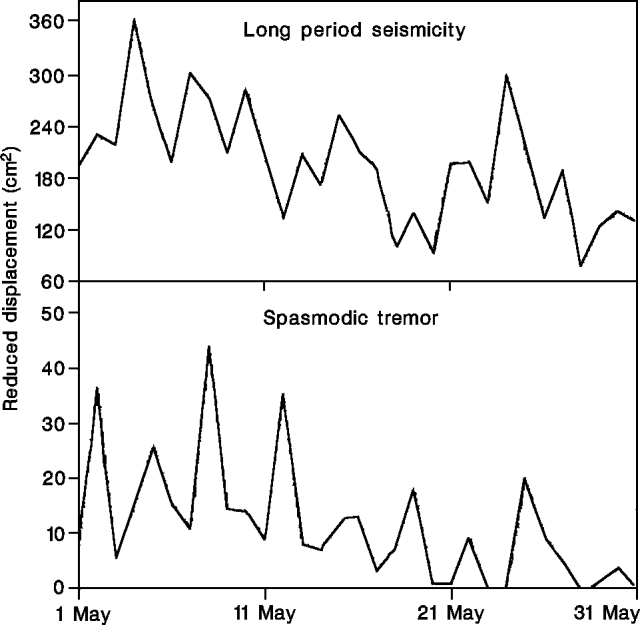Report on Galeras (Colombia) — May 1992
Bulletin of the Global Volcanism Network, vol. 17, no. 5 (May 1992)
Managing Editor: Lindsay McClelland.
Galeras (Colombia) Occasional explosions eject ash; strong fumarolic activity on 1991 dome; earthquakes and tremor decline
Please cite this report as:
Global Volcanism Program, 1992. Report on Galeras (Colombia) (McClelland, L., ed.). Bulletin of the Global Volcanism Network, 17:5. Smithsonian Institution. https://doi.org/10.5479/si.GVP.BGVN199205-351080
Galeras
Colombia
1.22°N, 77.37°W; summit elev. 4276 m
All times are local (unless otherwise noted)
Gas emission continued in May, occasionally accompanied by explosions that produced very fine ash, and noise from various points in the active crater. The observed explosions were associated with long-period earthquakes or variations in background tremor. SO2 flux was at low to moderate levels, ranging from ~250 to 650 t/d. Increased fumarole temperatures were measured on the SW (at Deformes fumarole) and W (at Besolima fissure) flanks of the cone, while strong fumarolic activity continued on the NW side of the 1991 dome.
Long-period seismicity and spasmodic tremor declined noticeably in May (figure 54). The few recorded high-frequency events were centered towards the W side of the crater, near the active cone, at <4.5 km depth, and M <2.0. A tremor episode that began on 31 May at 0451 was composed of two bands with durations of 33 and 18 minutes, separated by six tremor-free minutes. The tremor's dominant period was 0.5-1.0 seconds, and the released energy roughly 2.0 x 1011 ergs (reduced displacement of Rayleigh waves of 56 cm2 at the station 1.5 km from the crater). Another tremor episode, lasting 27 minutes with dominant periods of 0.2-0.4 seconds, was recorded in April. These tremor events were similar to those recorded in July-December 1991, associated with the formation and growth of the lava dome. A large long-period event recorded at 1920 on 6 June had a period of 1.5 seconds, and reduced displacements of 59 cm2 for Rayleigh waves, and 42 cm2 for body waves.
 |
Figure 54. Daily reduced displacement of long-period seismicity (top) and spasmodic tremor episodes (bottom) at Galeras, May 1992. Courtesy of INGEOMINAS. |
Electronic tiltmeter measurements in May indicated deformation trends similar to April. The tiltmeter [at Crater Station] indicated continued deflation, while the tiltmeter [at Peladitos Station] suggested minor inflation (see figure 58).
Geological Summary. Galeras, a stratovolcano with a large breached caldera located immediately west of the city of Pasto, is one of Colombia's most frequently active volcanoes. The dominantly andesitic complex has been active for more than 1 million years, and two major caldera collapse eruptions took place during the late Pleistocene. Long-term extensive hydrothermal alteration has contributed to large-scale edifice collapse on at least three occasions, producing debris avalanches that swept to the west and left a large open caldera inside which the modern cone has been constructed. Major explosive eruptions since the mid-Holocene have produced widespread tephra deposits and pyroclastic flows that swept all but the southern flanks. A central cone slightly lower than the caldera rim has been the site of numerous small-to-moderate eruptions since the time of the Spanish conquistadors.
Information Contacts: J. Romero, INGEOMINAS-Observatorio Vulcanológico del Sur.

